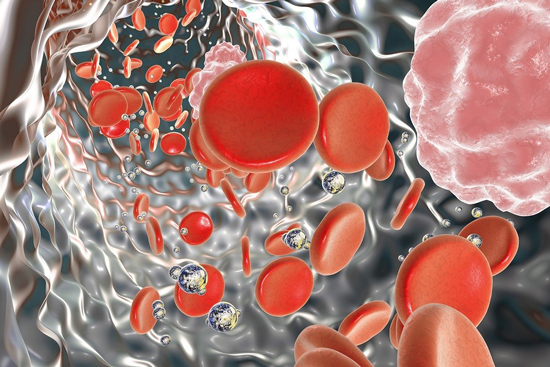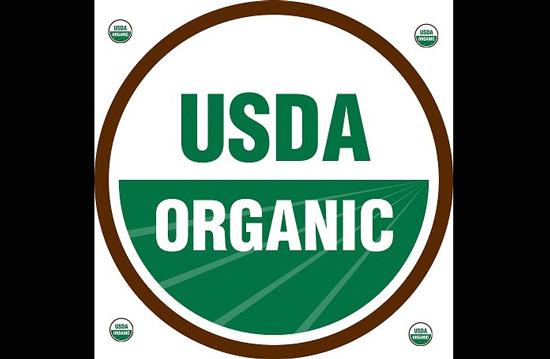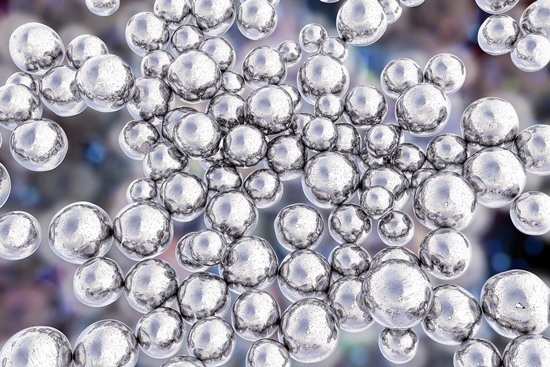Nanotechnology: the hidden danger in food and thousands of consumer products

Nanoparticles in blood
When it comes to creating and using nanoparticles, nanotubes, nanowires, quantum dots, and nano-machines, the attitude among scientists and product developers is: “If it can be done, then it should be done.” Another way of saying this is: “If we don’t know about the harm that it does, and then there isn’t any harm.”
This article refers to nanotechnology and human health. It examines our exposure to various forms of nanotechnology, and identifies the most harmful form of nano-toxicity.
How Small Is Nano?

Before we go deeper into this topic, let’s focus on the size of this technology. Nanosized substances are defined as having one dimension of their size being less than 100 nanometers. A nanometer (NM) is one billionth of a meter.
A double strand of DNA in a human cell is about 2 nanometers (nm) thick.
One way to visualize the size of a nanometer is to picture a football on a football field. If a human blood cell is represented by the size of the field, then the football itself would be a nanoparticle. Another way to visualize one nanometer is to consider that it is one-millionth the length of a grain of sand.
These substances can enter the human body when we eat, drink, breathe, and when they contact our skin. Once inside our bodies, they can travel through the blood system to any part of the body. They often concentrate in connective tissue. Some easily pass through the blood-brain barrier and enter the brain.
Some nanoparticles can be scavenged by cells of the immune system and removed from the body. Other nanoparticles stay stuck in tissues where they concentrate and become a toxic burden.
Nanotechnology in Food
The concerns of technology watchdog organizations naturally draw our attention to food and consumer products that contain nanoparticles, because this is where a great amount of nanotechnology is being implemented. For example, many of us were alarmed to learn that unapproved nanoparticles of various substances such as hydroxyapatite are being added to baby formula without evaluation for long-term health consequences.
Nanomaterials are being used to create new tastes and flavors, and to facilitate hygienic food processing and extended shelf-life packaging. They can be used in “intelligent packaging”, which changes color when the product spoils or reaches an expiration date, and can make food packaging lighter and stronger.
We are told that nanosized chemicals will reduce the amount of pesticides that are put into the environment during crop production, and will reduce the amount of chemicals that are needed to add color and flavor to processed food, and to preserve it.
Nanotechnology is used in Many Products Today
Nanoparticles of various types are also being used in hundreds of other products such as: pharmaceutical drugs, medical supplies, cosmetics and personal care products, energy storage devices, water treatment and air filtration equipment, environmental remediation technology, chemical and biological sensors, and in military explosives to name a few.
Nano-ingredients are used in: transparent sunscreens; light-diffracting cosmetics; penetration enhanced moisturizers; stain-, moisture-, and odor- repellent fabrics; long-lasting paints and furniture varnishes; anti-bacterial household appliances such as vacuum cleaners, refrigerators and air conditioners; and sporting equipment.
They are used in children’s skincare products and sunscreens, supplements, food containers, pacifiers, teethers, blankets, toys and stuffed animals, baby bottles, toothbrushes, baby carriages, bibs, and baby clothing.
Is Nanotechnology Too Complicated to Regulate?
In a 2012 World Health Organization (WHO) report, the panel of experts described their findings regarding the complex reality of nanotechnology. They stated:
“The WHO Regional Office for Europe undertook a critical assessment of the current state of knowledge and the key evidence on the possible health implications of nanomaterials, with a view to identify options for risk assessment and policy formulation, and convened an expert meeting to address the issue.
Current evidence is not conclusive. As complexity and uncertainty are large, risk assessment is challenging, and formulation of evidence-based policies and regulations elusive.”
In other words, the WHO recognizes that there are hundreds of thousands of manmade nano-creations – so many that safety studies couldn’t be done on them all.
They know there are risks, but they aren’t sure what they should do to manage the situation. They decided to keep studying the situation and to recommend that policy frameworks be established to assess potential risks without going so far as to insist on formal safety studies.
Nanoparticles Behave in Unusual and Unexpected Ways: Contribute to Developmental Problems and Chronic Illness
Nanoparticles behave in unusual and unexpected ways, and can contribute to developmental problems and chronic illness even though larger particles of the same material have much less risk of harm.
Some scientists and doctors think that the unpredictable behavior of nano-ingredients could produce unanticipated damage to human health. The U.S. Occupational Safety and Health Administration (OSHA) understands the potential for risk and is regulating worker exposure to nano-materials to prevent these materials from being inhaled, swallowed, or from coming into contact with the skin.
However, the FDA has chosen to not regulate this same nanotechnology when it is used in food or consumer products. This is at the heart of the nanotechnology controversy. A product might be considered Generally Recognized as Safe (GRAS) for use in food, however, when it is nanosized, it can have very different properties, which could be harmful to health.
Manufacturers are saying that if a substance is GRAS, then it will always be GRAS regardless of the particle size. Therefore, they don’t believe they need to do safety studies on these nanoparticles.
Scientists are constantly examining what happens when they nanosize substances. They can’t always predict how specific nanoparticles will behave until they play with them in the laboratory and discover their unique properties.
However, these unique properties might also produce unique health risks, which might only show up during human exposure.
Relying on GRAS status and making an assumption of safety based on that determination is a dangerous practice. The problem is that scientists, and the corporations that fund their research, are looking for novel properties and are not willing to use their resources to study health risks unless such studies are required.
Scientists Admit that the Risks of Nanotechnology are Largely Unknown
At this point, forward looking scientists admit that they really don’t understand the full set of risks associated with nanotechnology.
A 2014 literature review conducted by scientists at Louisiana State University stated: “The safety of nanodelivery systems for use in food applications is largely unknown. Toxicological studies consisting of a combination of in silico, in vitro, and in vivo studies are needed to reveal the safety of nanodelivery systems for successful applications in food and agriculture.”
The FDA does not Regulate Nanotechnology: Even USDA Organic Foods May Contain Nanoparticles

The U.S. government does not prohibit or regulate the inclusion of manmade nanoparticle additives in baby food, adult food, cosmetics, or consumer products, and does not prohibit nanoparticles from being used in certified organic food. Even synthetic nano-ingredients can be approved for use in organic food on a case by case basis.
Based on the “Nonbinding Recommendations” of the FDA for nanotechnology used in food and cosmetics, manufacturers are not required to list the wide range of nanosized chemicals they use in their products. They also are not required to disclose the presence of nanosized substances on their labels or to test long-term health consequences.
OSHA Regulates Nanotechnology to Prevent Worker Harm
Even though the FDA doesn’t require safety studies for nanotechnology used in food and cosmetics, the U.S. Occupational Safety and Health Administration (OSHA) considers nanotechnology a serious matter and has put standards in place to protect workers from breathing, ingesting, or having skin contact with nanosized materials.
Isn’t it strange that nano-sized substances are regulated by OSHA to protect human workers, but the same substances aren’t worthy of regulation by the FDA to protect human consumers?
Should We Be Concerned about All These Forms of Manmade Nanotechnology?
Some nanoparticles such as those found in wood smoke and sea spray exist in nature, but these are not the concern here – the real concern is manmade nanotechnology.
It is the nanosized substances and the engineered nanoparticles that are being added into products and those being released into the environment that are of concern.
Nanoparticles include structures of various shapes, such as nanotubes, nanowires, quantum dots, and fullerenes.
The safety of these manmade nano-structures is largely unknown, because those who manufacture them are not required to prove that they are safe prior to their use. Corporations basically have a green light – it’s full speed ahead until something bad happens.
Are Nanotechnology Health Concerns Known?
As You Sow, an advocacy group raising awareness of nanotechnology, provides us with the following information. They state:
“Recent research on the ingestion of nanoparticles has raised concerns regarding their toxicity to humans and the environment. Research suggests that nanoparticles of many materials are more biologically active than their normal size counterparts because they have significantly greater surface area per mass. A sample of peer-reviewed studies from the field of nanotoxicology shows that:
– Nanoparticles less than 300 nm are able to pass through cell membranes in organisms, and their interactions with biological systems are relatively unknown.
– Silver nanoparticles have a toxic effect on human and mice testicular cells, suppressing cellular growth and multiplication and causing cell death.
– Mice fed certain kinds of titanium dioxide nanoparticles with their drinking water for 5 days exhibited DNA and chromosomal damage and inflammation.
– Male offspring of pregnant mice injected with certain titanium dioxide nanoparticles experienced genital malformations and neurologic damage as well as changes in gene expression in the brain.
– In vitro studies have suggested that some types of both titanium dioxide and zinc oxide nanoparticles are toxic to human brain and lung cells.”
Titanium dioxide is used as a whitening agent in food and pharmaceuticals. The Guardian reported that titanium dioxide is in almost every white consumer product, including sun screen, toothpaste, and the powdered sugar used on donuts. After pressure from a stockholder resolution, Dunkin’ Donuts has decided to remove titanium dioxide from the powdered sugar it uses on its products.
The article in the Guardian stated:
“Last year [2014], As You Sow filed a shareholder resolution asking Dunkin’ Brands, the parent company of Dunkin’ Donuts, to identify products that may contain nano materials, and to assess the risks of using these substances in foods. The company was using food grade titanium dioxide on its powdered sugar products, and maintained that it included no nanoparticles. However, an independent test commissioned by As You Sow found otherwise. …
While titanium dioxide has been deemed safe for human consumption, the safety of nano titanium dioxide has not been studied, and activists are concerned that nanoparticles are now essentially being tested on the American public.”
As You Sow compares the emergence of current nanotechnology to the untested use of asbestos.
They state: “Asbestos litigation is a good example of the risks that can arise from using an emerging technology before it is proven safe. Use of asbestos (a nanomaterial) has created the longest, most expensive mass tort in national history with total U.S. costs now standing at over $250 billion. If companies had been asked to investigate and minimize or avoid risks prior to adopting asbestos technology, a sad and expensive chapter in worker harm could have been avoided.”
Nano-Aluminum: The Biggest Nanotechnology Problem

The greatest nanotechnology threat that we all face every day comes from nano-aluminum. The harm being caused by the inhalation of nano-aluminum is so pervasive and so overwhelming that few can even comprehend it.
Government regulators and policy analysts do not generally acknowledge that nano-aluminum is being sprayed into the upper atmosphere over us every day and that nano-aluminum is a health hazard.
Nanoparticles of aluminum, barium, and strontium are being released into the atmosphere through the U.S. government’s high-altitude spraying program. This process, which supposedly is designed to slow global warming, is contaminating the air we breathe, the water we drink, and the soil that grows our food. As a result, we are breathing nano-aluminum, eating nano-aluminum, and having constant skin contact with nano-aluminum. Our bodies are accumulating nano-aluminum and other nanoparticles, and we have become storage dumps for these toxic metals.
The harm that is being produced by breathing air and eating food containing nanoparticles of aluminum effects every person in the United States even if we eat organic food, reject vaccinations containing aluminum adjuvants, avoid using pesticides and other toxic chemicals, and do our best to live a healthy lifestyle.
The topic of aerial spraying for climate control was addressed in a 2015 Health Impact News article Artificial Clouds and Geoengineering: Public Exposed to Toxic Chemicals:
“For those of us who are old enough, we remember that the color of the sky on a clear day was a deep rich blue.
We seldom see that color with the level of depth and intensity that it once had.
Today there is usually a milkiness to the blue. We have new forms of clouds, which are formed from massive numbers of persistent contrails. These cloud formations are manmade and never occur naturally.
Normal contrails from jet aircraft will dissipate in 30 to 60 seconds. These contrails are mostly water vapor. Today you will see persistent contrails that stretch from horizon to horizon. They crisscross through the sky over us and last for hours as they slowly spread into wider and wider bands of whitish-gray.
Close observation of aircraft with telephoto lenses shows us that the contrails are not jet engine exhaust, but are being released from other locations of the aircraft.”
The Harm Caused by Nano-Aluminum is Intensified by Glyphosate and Mercury

In the presence of the herbicide glyphosate and/or mercury, nano-aluminum becomes extremely harmful. It easily passes through the blood-brain barrier and gets lodged in brain cells. It disrupts brain development of children and slowly damages the cognitive activities of adults. It suppresses energy production in mitochondria, and suppresses the immune system. It causes behavior abnormalities and creates a perfect environment for supporting parasites.
Nano-Aluminum Cannot Be Escaped As Long As We Are Breathing Air and Eating Food
Nanoparticles of aluminum are so small that they are nearly impossible to filter from air.
Similarly, they enter our bodies with the water we drink and with the food we eat whether or not the food is certified organic.
Nanoparticles of aluminum, barium, and strontium are constantly falling from the sky over the United States and drift in the air for hundreds of miles.
Conclusion: Nano-aluminum from Aerial Spraying May be the Most Harmful Form of Nanotechnology
As far as we know right now, nano-aluminum from aerial spraying may be the most harmful form of nanotechnology.
Nano-aluminum is likely to be more harmful than other nanotechnology, because of our constant exposure, and the presence of glyphosate and mercury in our bodies.
Glyphosate and mercury drive nano-aluminum deep into every cell in our bodies where it accumulates and disrupts every aspect of our life.
We don’t yet know the extent to which other nanotechnology is harming human life, because no long-term safety studies have been done. We also don’t know about the synergy between these other nano-substances and how they interact with glyphosate and mercury in the body.
However, we do know about the power of nano-aluminum to destroy health.
In the short-term, we cannot stop our daily exposure to nano-aluminum, but we can pursue strategies to remove the nano-aluminum from our brains and our bodies to create the possibility of being physically healthier and mentally more clear-minded.
Without taking proactive steps to remove the aluminum and to strengthen our immune system, we will find ourselves getting sicker and sicker. Our strength will steadily wither as conditions within us reach a tipping point where death from one of the epidemic modern illnesses such as heart disease, cancer, or Alzheimer’s will take our lives.
Sadly, the prospect of gracefully living into old-age with a clear mind and strong body will not be realized by most of us unless we take strong affirmative steps to enter into a life-long process of detoxification and parasite removal. Becoming healthy and staying healthy now requires deliberate effort.
The good news is that we can turn our health around and prevent ourselves from becoming a victim of modern chronic illnesses. We don’t need to hand our bodies and our minds over to the pharmaceutical drug cartel and the conventional medical care system that it controls – there are other alternatives.
yogaesoteric
March 23, 2018
